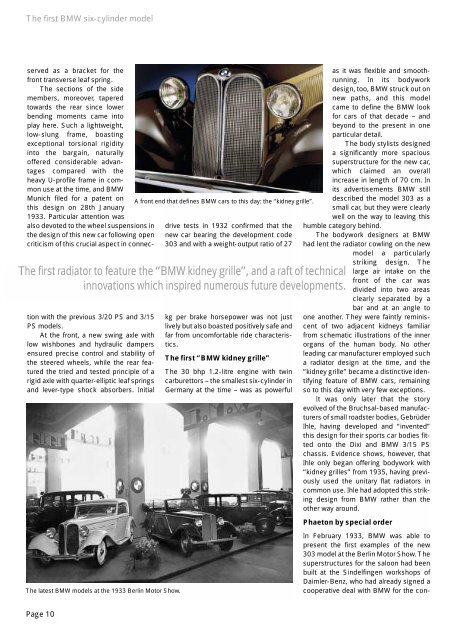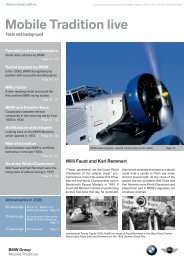Mobile Tradition live - BMW Car Club Brasil
Mobile Tradition live - BMW Car Club Brasil
Mobile Tradition live - BMW Car Club Brasil
Create successful ePaper yourself
Turn your PDF publications into a flip-book with our unique Google optimized e-Paper software.
The first <strong>BMW</strong> six-cylinder model<br />
served as a bracket for the<br />
front transverse leaf spring.<br />
The sections of the side<br />
members, moreover, tapered<br />
towards the rear since lower<br />
bending moments came into<br />
play here. Such a lightweight,<br />
low-slung frame, boasting<br />
exceptional torsional rigidity<br />
into the bargain, naturally<br />
offered considerable advantages<br />
compared with the<br />
heavy U-profile frame in common<br />
use at the time, and <strong>BMW</strong><br />
Munich filed for a patent on<br />
this design on 28th January<br />
1933. Particular attention was<br />
also devoted to the wheel suspensions in<br />
the design of this new car following open<br />
criticism of this crucial aspect in connec-<br />
tion with the previous 3/20 PS and 3/15<br />
PS models.<br />
At the front, a new swing axle with<br />
low wishbones and hydraulic dampers<br />
ensured precise control and stability of<br />
the steered wheels, while the rear featured<br />
the tried and tested principle of a<br />
rigid axle with quarter-elliptic leaf springs<br />
and lever-type shock absorbers. Initial<br />
The latest <strong>BMW</strong> models at the 1933 Berlin Motor Show.<br />
Page 10<br />
A front end that defines <strong>BMW</strong> cars to this day: the “kidney grille”.<br />
drive tests in 1932 confirmed that the<br />
new car bearing the development code<br />
303 and with a weight-output ratio of 27<br />
The first radiator to feature the “<strong>BMW</strong> kidney grille”, and a raft of technical<br />
innovations which inspired numerous future developments.<br />
kg per brake horsepower was not just<br />
<strong>live</strong>ly but also boasted positively safe and<br />
far from uncomfortable ride characteristics.<br />
The first “<strong>BMW</strong> kidney grille”<br />
The 30 bhp 1.2-litre engine with twin<br />
carburettors – the smallest six-cylinder in<br />
Germany at the time – was as powerful<br />
as it was flexible and smoothrunning.<br />
In its bodywork<br />
design, too, <strong>BMW</strong> struck out on<br />
new paths, and this model<br />
came to define the <strong>BMW</strong> look<br />
for cars of that decade – and<br />
beyond to the present in one<br />
particular detail.<br />
The body stylists designed<br />
a significantly more spacious<br />
superstructure for the new car,<br />
which claimed an overall<br />
increase in length of 70 cm. In<br />
its advertisements <strong>BMW</strong> still<br />
described the model 303 as a<br />
small car, but they were clearly<br />
well on the way to leaving this<br />
humble category behind.<br />
The bodywork designers at <strong>BMW</strong><br />
had lent the radiator cowling on the new<br />
model a particularly<br />
striking design. The<br />
large air intake on the<br />
front of the car was<br />
divided into two areas<br />
clearly separated by a<br />
bar and at an angle to<br />
one another. They were faintly reminiscent<br />
of two adjacent kidneys familiar<br />
from schematic illustrations of the inner<br />
organs of the human body. No other<br />
leading car manufacturer employed such<br />
a radiator design at the time, and the<br />
“kidney grille” became a distinctive identifying<br />
feature of <strong>BMW</strong> cars, remaining<br />
so to this day with very few exceptions.<br />
It was only later that the story<br />
evolved of the Bruchsal-based manufacturers<br />
of small roadster bodies, Gebrüder<br />
Ihle, having developed and “invented”<br />
this design for their sports car bodies fitted<br />
onto the Dixi and <strong>BMW</strong> 3/15 PS<br />
chassis. Evidence shows, however, that<br />
Ihle only began offering bodywork with<br />
“kidney grilles” from 1935, having previously<br />
used the unitary flat radiators in<br />
common use. Ihle had adopted this striking<br />
design from <strong>BMW</strong> rather than the<br />
other way around.<br />
Phaeton by special order<br />
In February 1933, <strong>BMW</strong> was able to<br />
present the first examples of the new<br />
303 model at the Berlin Motor Show. The<br />
superstructures for the saloon had been<br />
built at the Sindelfingen workshops of<br />
Daimler-Benz, who had already signed a<br />
cooperative deal with <strong>BMW</strong> for the con-







